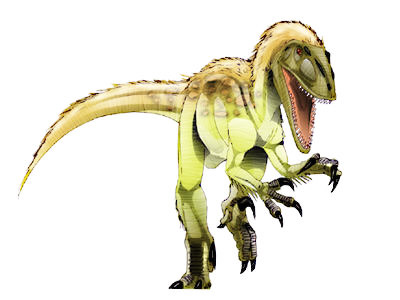Dakotaraptor
Junior Member
  Used to be Metriacanthosaurus
Used to be Metriacanthosaurus
Posts: 193 
|
Post by Dakotaraptor on Nov 2, 2013 23:44:20 GMT 5
Dilophosaurus wetherilli Dilophosaurus Dilophosaurus is a genus of theropod dinosaur from the Sinemurian stage of the Early Jurassic Period, about 193 million years ago. The first specimens were described in 1954, but it was not until over a decade later that the genus received its current name. Dilophosaurus has appeared several times in popular culture, such as in the 1993 film Jurassic Park. Dilophosaurus measured around 6-6.4 metres (20-21 ft) long and may have weighed 283-500 kilograms (624-1100 lb).
Achillobator giganticus
Achillobator is a dromaeosaurid theropod dinosaur that lived roughly 98 to 83 million years ago during the Late Cretaceous in what is now Mongolia, in Asia. It was among the largest dromaeosaurs; the holotype and only known individual of Achillobator is estimated at 6 m (19.7 ft) long. Achillobator was a moderately-built, ground-dwelling, bipedal carnivore. It would have been an active predator, hunting with the enlarged, sickle-shaped claw on the second toe. *Size comparison* 
|
|
|
|
Post by Runic on Nov 2, 2013 23:46:05 GMT 5
The dromaeosaur would win after an irrelevant struggle. Dilophosaurus didn't seem like it could hold off medium sized predators in a death fight even with size. I could be wrong though.
|
|
Deleted
Deleted Member
Posts: 0
|
Post by Deleted on Nov 15, 2013 23:51:52 GMT 5
Achillobator. Weren't dilophosaurs poorly armed and didn't take large prey?
|
|
|
|
Post by Godzillasaurus on Nov 22, 2013 19:33:29 GMT 5
Achillobator. Weren't dilophosaurs poorly armed and didn't take large prey? Dilophosaurus, as least compared to many other large theropods, seemed to have been much better built for preying on smaller animals, as evidenced by its lightly-built jaws (and overall build), slender teeth, and notch in the upper jaw (which could have been used to hook small animals, similar to the frontal notch found in spinosaurid jaws). Because of this, I favor achillobator |
|
Deleted
Deleted Member
Posts: 0
|
Post by Deleted on Nov 27, 2013 0:12:46 GMT 5
Achillobator. Weren't dilophosaurs poorly armed and didn't take large prey? Dilophosaurus, as least compared to many other large theropods, seemed to have been much better built for preying on smaller animals, as evidenced by its lightly-built jaws (and overall build), slender teeth, and notch in the upper jaw (which could have been used to hook small animals, similar to the frontal notch found in spinosaurid jaws). Because of this, I favor achillobator Ok so I'm correct? |
|
|
|
Post by theropod on Nov 27, 2013 1:30:02 GMT 5
Not much has been properly analysed about dilophosaurid jaw mechanics.
This is why many have made guesses some of which are rather laughable but still found a lot of popularity. Bakker once suggested their skulls to have been exceedingly kinetic to swallow large stuff whole (like snakes), but this has been rejected ever since.
It has been suggested that the kinetic junctgion between premaxilla and the rest of would have made the skull unsuited for predation on large prey, which also doesn't stand up to closer consideration; had the animal been an exclusive scavenger (not only is this evidently impossible for terrestrial predators...), the exact opposite adaption would be expected, kinetic skull parts don't make sense for carcass dismemberment.
More likely this is actually an adaption for manipulating prey, the loose connection absorbing stresses a struggling animal may excert. The anterior dentary and premaxillary dentition are unserrated which may be an adaption for a gripping purpose. And this wouldn't necessarily be restricted to small prey, but may find application for holding onto something larger too (given there's sufficient strenght in the neck, which I wouldn't claim not to be the case without reasons; of course the skeletal above shows a rather shrink-wrapped neck which is why it looks so emaciated).
There's no reason why their jaws wouldn't have made effective killing tools apart from that. The Dinosauria describes the rest of the dentition as "powerful" and doesn't find anything to argue they were not able to subdue prey.
Their very light and cursorial (compared to similar-sized highly macropredaceous theropods such as dromaeosaurs or carnosaurs) may indicate predominant predation on relatively small prey, but that might be deceiving since dilophosaurs are simply relatively small for their dimensional size (thus in the end not being as large as they seem). Often people tend to overestimate how built differences affect a comparison at similar weights because they are used to comparisons that show them at similar dimensions.
I wouldn't characterise Dilophosaurus as particularly well armed, neither necessarily as whimpy as some tend to believe.
|
|
|
|
Post by creature386 on Nov 27, 2013 2:26:15 GMT 5
|
|
|
|
Post by Infinity Blade on Nov 29, 2013 22:30:28 GMT 5
At parity, Achillobator. But isn't Dilophosaurus around 500 kilograms?
|
|
|
|
Post by theropod on Nov 29, 2013 22:54:15 GMT 5
The more I look at its skeletal in size comparisons, the more I doubt that Dilophosaurus was really anywhaere near that weight.
To me they seem fairly similar, both perhaps 200-300kg
|
|
Carcharodon
Junior Member
  Allosauroidea Enthusiast
Allosauroidea Enthusiast
Posts: 211
|
Post by Carcharodon on Dec 21, 2013 1:11:10 GMT 5
Achillobator wins imo due to better weaponry.
|
|
Deleted
Deleted Member
Posts: 0
|
Post by Deleted on Mar 27, 2018 10:22:57 GMT 5
I would say so as well, though Dilo is pretty strong too.
|
|
|
|
Post by dinosauria101 on Feb 12, 2019 21:13:05 GMT 5
I might actually give the edge to Dilo, it's almost twice as big (350 vs 600 kg)
|
|